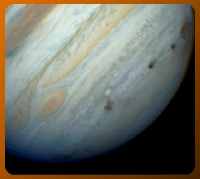You are seeing this message because you are using an out-of-date browser.
Please click here for more information.
A String of Pearls

Image courtesy of: Hubble Space Telescope
During the Spring of 1993, William and Carolyn Shoemaker and David Levy discovered a
new comet, which was a cause for celebration all by itself. The real excitement
began after they studied the new comet's orbit through our solar system. They
discovered that the comet had passed through our solar system a year earlier
and had been broken up into the pieces shown in the picture above. They also
discovered that the comet was going to return in 1994 and collide with Jupiter.

Image courtesy of: Hubble Space Telescope
Impact!

Image courtesy of: Hubble Space Telescope
The news of a comet impacting Jupiter electrified the astronomy community and
the world at large. For the next year, scientists and astronomers prepared to
observe something that we had never seen before. It was a very exciting time.
Image courtesy of: Hubble Space Telescope
Starting on July 16th and continuing for about a week, we all watched in wonder as pieces of the comet rained down on Jupiter. The impacts had a greater effect than we had even dreamed they would. The impacts were so large that the Hubble Space Telescope captured breathtaking images like the one at right. Some larger telescopes here on Earth were also able to see the impact sites, which are the dark patches in the images at the right. You can also see Jupiter's Great Red Spot in the image, which should give you a good idea just how large the comet's impacts were.
The numerous black smudges visible in this picture show how different fragments of the comet hit Jupiter at different times. By the time the impacts started, the fragments of the comet were scattered out over thousands and thousands of miles, which explains why it took almost a week for the last fragment to hit the giant planet.

Image courtesy of: Hubble Space Telescope
The impacts gradually faded from view, but it took over a year for the largest impact sites to disappear completely. Those of us lucky enough to be a part of this experience will never forget it.
This entire site copyright © 2003 Astronomy for Kids - all rights reserved

